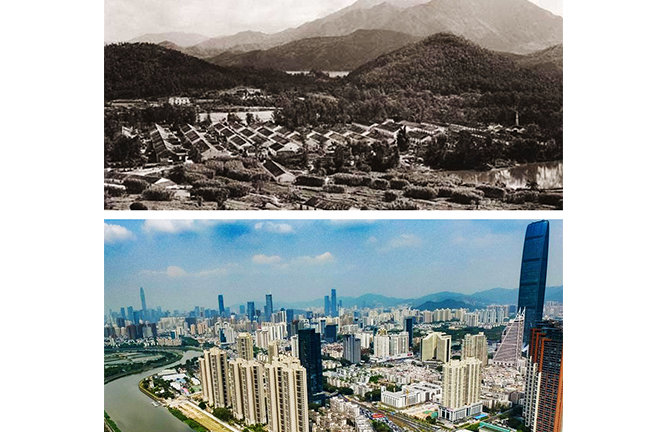Shenzhen SEZ epitome of reform and opening up
 Shenzhen has transformed from a small fishing village into an international metropolis over the past four decades since a SEZ was established. Photo: SINA and XINHUA
Shenzhen has transformed from a small fishing village into an international metropolis over the past four decades since a SEZ was established. Photo: SINA and XINHUA
On Oct. 14, China held a grand gathering to celebrate the 40th anniversary of the establishment of the Shenzhen Special Economic Zone (SEZ) in southern Guangdong Province, a paragon of China's reform and opening up.
Chinese President Xi Jinping, also general secretary of the Communist Party of China Central Committee and chairman of the Central Military Commission, attended the gathering and delivered an important speech.
Xi identified the valuable experience of Shenzhen and other SEZs, including adhering to the Party's leadership, upholding and improving the system of socialism with Chinese characteristics, adhering to the concept that development is of paramount importance, remaining committed to opening up on all fronts, taking innovation as the primary driving force, following the people-centered philosophy of development, and ensuring scientific legislation, strict law enforcement, judicial impartiality, and universal law abiding.
He also highlighted experience, such as achieving sustained development of economy and society as well as ecology and environment in a comprehensive and coordinated way, and giving full play to the leading and exemplary role of the SEZs while making overall plans for the country.
Transforming from a small impoverished fishing village into an international metropolis, Shenzhen SEZ has made enormous social and economic progress over the past four decades, attracting worldwide attention, said Wang Tongsan, a Member of the Chinese Academy of Social Sciences.
The GDP of Shenzhen increased from 270 million RMB in 1980 to 2.7 trillion RMB in 2019, an average annual growth rate of 20.7%.
Tao Yitao, director of the China Center for Special Economic Zone Research at Shenzhen University, said that Shenzhen's GDP increased 10,000 times in 40 years, ranking third among large and medium-sized cities in the country, and its export scale has ranked first among large and medium-sized cities nationwide for 27 consecutive years since 1993. Based on the permanent population, Shenzhen's GDP per capita has increased 319 times in the past four decades.
Private enterprises have made outstanding contributions to Shenzhen's economic development, contributing over 60% of taxes, over 70% of economic growth, over 70% of patent applications, and over 94% of the city's foreign trade growth, Tao noted.
In the past 40 years, Shenzhen has developed from a town with "no higher education institutions, no scientific research institutes, and no innovation carriers" to an international and innovative city full of charm, motivation, vitality and innovation.
Mao Yanhua, deputy director of the Institute of Free Trade Zones at Sun Yat-sen University, said that through constant innovative development, Shenzhen has gradually explored and pioneered a market-oriented path of scientific and technological innovation in which enterprises are the main players and synergy is created through the joint efforts of enterprises, universities and research institutes. It is characterized by 90% of R&D personnel, R&D institutions, scientific research investment, and patent production concentrated in enterprises.
An important reason for the rise of Shenzhen is that it has effectively handled the relationship between development and institutional innovation.
Zheng Yongnian, director of the Advanced Institute of Global and Contemporary China Studies at the Chinese University of Hong Kong, Shenzhen, said that development requires institutional innovation, and the results of development need to be guaranteed by the system. In the past 40 years, due to the full authorization of the central government, Shenzhen’s institutional innovation has been at the forefront of the country. These institutional innovations have contributed to the rapid development of Shenzhen in all aspects.
In Wang's view, taking the lead in carrying out market-oriented economic system reforms is not only the fundamental guarantee of Shenzhen's economic and social development, but also makes Shenzhen the cornerstone and starting point for the country’s socialist market economy.
Opening up and integrating into the global economic system are essential for Shenzhen, said Lin Chen, a professor from the School of Applied Economics at Renmin University of China. Since the reform and opening up, Shenzhen has introduced a large amount of foreign direct investment in an open and tolerant way, and it has brought advanced production technologies, modern management modes and sales channels in international markets into the country, which is equivalent to establishing from scratch an industrial system that is deeply integrated into the global division of labor. Shenzhen has also developed an export-oriented economy and export-oriented industries, actively and deeply participated in international competition, and shaped its efficiency in this competitive environment.
The industrial characteristic of deep participation in international competition determines that Shenzhen's industries will change as China’s comparative advantages change, Lin continued. Over the past four decades of reform and opening up, the open competitive environment has created manufacturing industry’s success in Shenzhen.
At present, Shenzhen is starting to see high-tech concentration, high-tech talent concentration and capital concentration, Lin said. These changes have reshaped Shenzhen’s comparative advantages. From the perspective of global competitive advantage, it is promising that high-tech R&D, producer services and financial industry will become the driving force of Shenzhen’s next stage of development.
Edited by JIANG HONG
